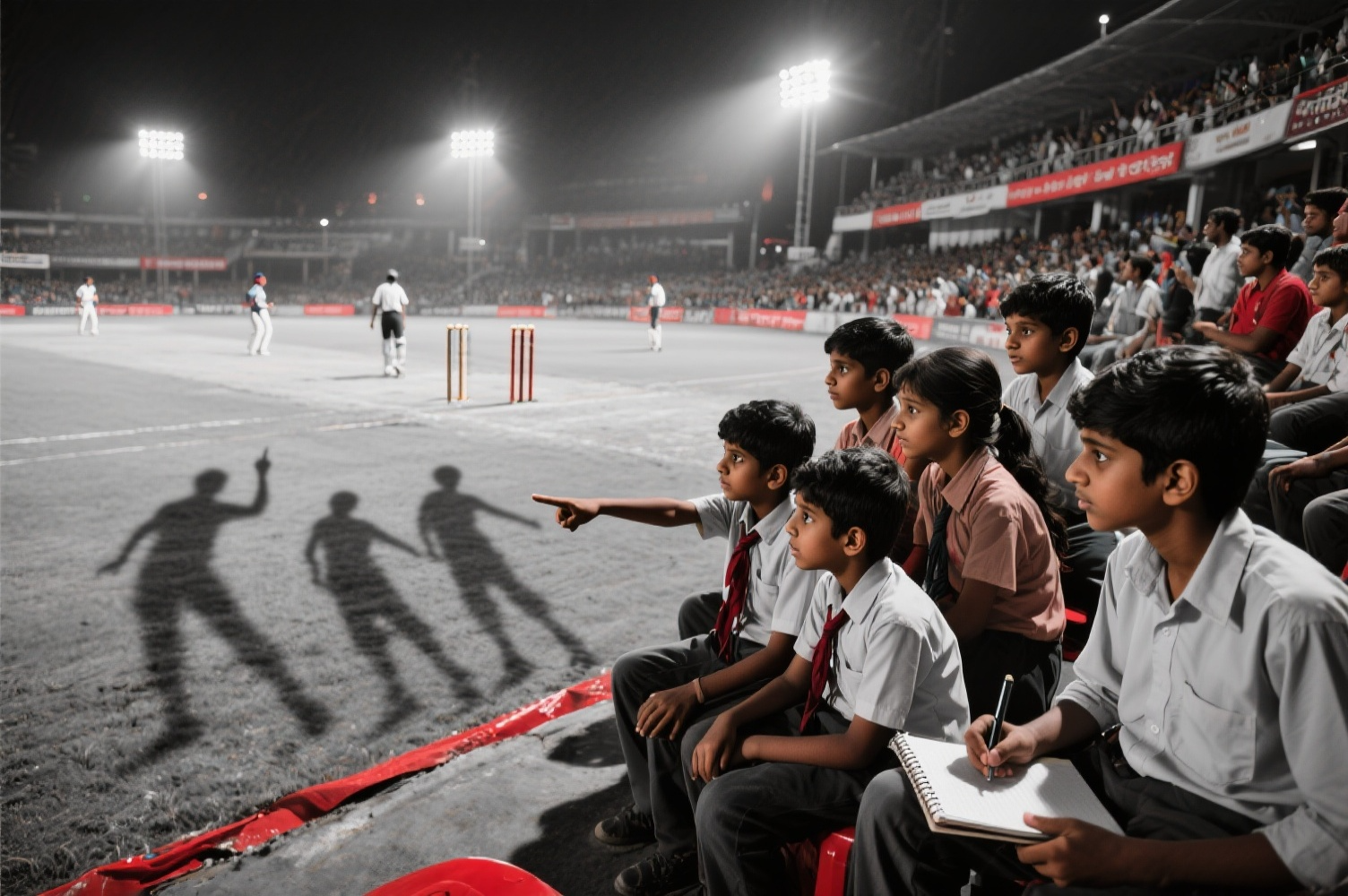- December 9, 2023
- by Educational Initiatives
- Blog
- 0 Comments
This article is from our archives.
“India vs Australia cricket match! Right here in our town”, Manoj was running with a newspaper in his hand heading for Team Bachcha! Team Bachcha was a team of kids crazy about cricket. None of them wanted to miss this match at the grounds. Manoj brought the news to the group and each one of them started dreaming about how they would be able to see their heroes face to face and how the pitch would light up with the huge bright lights towards the evening.
At the grounds, Ali, Neeti, Manoj, Preyal, Sushil and Danny were cheering the Indian team louder than anyone else in the stand. Ali, the team captain and Neeti, one of the top players in Team Bachcha were looking slightly distracted. Their eyes seemed to follow something constantly. Sushil was getting quite restless and Danny was unable to find anything more interesting than the way the bowl bounced. Preyal took the lead and nudged Ali, “Are you okay? What is it that’s bothering you?
“I am a bit surprised. There are six reflections of one single person falling…” said Ali.
“And that is true for the stumps too!” Neeti added.
“What do you mean by reflections? I can’t see any mirror around!” said Danny
“I am talking about those black things falling around, I mean those things that appear when light falls on them”, Ali said.
Sushil was getting distracted too and said, “Oh! You are talking about shadows! But you are right, there should be only one shadow. How can there be so many?”
Shadows can be quite fascinating for young kids, especially when they are learning about light or related concepts at school. Students tend to be curious about the new things they learn. Concepts like light, shadows, reflection get students quite curious and might lead to several notions depending on what they see around them.
Preeti said, “My sister was telling Mom about a monster in the garden that wouldn’t leave her. A dark thing formed when light fell on her. “She is very small and does not even know what a shadow is.” The others giggled.
The ball swung high in the air as they held their breath. The fielder dived to catch it and fell flat on the ground. The crowd cheered loudly, while Neeti shouted, “His shadows have disappeared!” Danny tried to reason it, “See, a shadow is formed when one part of our body gets light. The other part does not get light and it appears as a shadow on the other side. Here the entire top portion of the player’s body is getting light and so there is no shadow formed.”
A spectator sitting behind them was listening patiently. He was a young researcher, who got quite curious about their talk and started interacting with them. He asked them where they lived and if he could come and talk to them the next evening.
The next day he went to the children and asked them a simple question. “What do you mean by a shadow?” There were several responses, the most common being, “A shadow is a reflection of an object when light falls on it” Some others said, “It’s like this dark object formed when light falls on it” Danny stuck to his explanation, “a shadow is formed by the part of the object that does not get light and a shadow is a dark light.” The researcher showed the following question to them.

The question shown above was taken by around 3464 Class 4 students in a nation-wide diagnostic test, ASSET. Below is a graph showing how the students answered the question.

The Bachchas Team is a group of six Class 5 students who are really crazy about cricket They had recently attended a live cricket match and had returned with some puzzling ideas about how shadows were formed.
For once, the focus was not on how the batsman flung the bat in the air But on how many shadows were falling on the ground. One of kids even noticed how the shadow disappeared when the bowler dived to get the catch and fell flat on the ground.
A researcher sitting next to them patiently heard their ideas and just before the game got over asked if he could talk to them a little bit more about these ideas the next day
These students were struggling with the concept of light and shadows and according to the researcher had some misconceptions He felt it was important to try and understand why they occurred. He thought it would be good to do some discussions and try and help the students solve these queries for themselves. The very next day he took a couple of torches, a cricket ball, a large sheet of paper and another sheet of paper with a question on it (The question is reproduced above.)
He showed them the question first. Ali, Neeti, Sushil and Preyal thought option B was the correct answer. Danny and Preeti said that it should look like option A. He could see a hidden pattern in the way these children thought He got even more curious and asked Sushil to explain how he arrived at that answer.
Sushil said that because of the torch’s light, the shadow of the ball and the shadow of the big cube would come together and look like B. Ali, Neeti and Preyal agreed to the idea and believed that the shadow of both the objects would be formed because they were coming in the path of light and they would join and appear on the screen as B.
This seemed to be an interesting answer and now it was important to ask if Danny and Preeti agreed. While watching cricket, Danny had explained that, “shadows are formed when one side of the object receives light” so the researcher asked them how he came to choose the answer A?
Danny very confidently said, “Because the ball is small and it is in front of the cube. Its shadow will be formed but will not reach the screen because the big cube will block it The shadow of the cube will also be formed and it will look like A because the front side and the back side both look like a square. The front side receives light but the back side doesn’t and that side will appear on the screen.”
Preeti explained her notion of shadows as, ‘A shadow forms when light doesn’t reach the screen or the other side because of it being blocked by something. That big cube is blocking the shadow of the cube so the screen will get light from everywhere except the part of the cube. And it will be square because the cube blocking it looks like a square from one side.”
The students were wondering what the correct answer could be. They kept asking the researcher for a correct answer. He gave them a torch, a cricket ball and asked them to get a lunch box and try this experiment out
Our research shows that students have various notions about shadows During the series of student interviews conducted by our team members we came across several such responses. The chart below the question shows how students responded to the question.
How do we explain these notions?
Some students like Danny tend to think that the shadow is the dark side of the object. A shadow is a dark object and it is seen when only one side gets light. Students with these notions might also believe that shadows are always present somewhere and we see them only when light falls on the object
Students like Ali, Neeti and Sushil think of shadows as reflections of objects. It is possible that they were talking of reflections as seen in a mirror. They believe that when an object is illuminated we see its reflection and the same logic applies for shadows.
While teaching concepts like light, reflection, shadows etc. it is important to lay emphasis on the scientific principles and not just merely the observations. Students might observe something and in order to make sense out of what they see connect them to prior experiences that might lead them to alternate conceptions or misconceptions.
Students need to learn, observe and reason the nature of shadows and understand that they are nothing but absence of light. The ignorance of the same could have various effects on certain other topics related to light like the way light interacts with matter and its properties.



